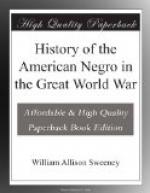“Thousands of American heavy guns fired the parting shot to the Germans at exactly 11 o’clock this morning. The line reached by the American forces was staked out this afternoon. The Germans hurled a few shells into Verdun just before 11 o’clock.
“On the entire
American front from the Moselle to the region of
Sedan, there was artillery
activity in the morning, all the
batteries preparing
for the final salvos.
“At many batteries the artillerists joined hands, forming a long line as the lanyard of the final shot. There were a few seconds of silence as the shells shot through the heavy mist. Then the gunners cheered. American flags were raised by the soldiers over their dugouts and guns and at the various headquarters. Soon afterward the boys were preparing for luncheon. All were hungry as they had breakfasted early in anticipation of what they considered the greatest day in American history.”
The celebration, which occurred November 11, upon announcement of the news, has never been equalled in America. It spontaneously became a holiday and business suspended voluntarily. Self-restraint was thrown to the winds for nearly twenty-four hours in every city, town and hamlet in the country. There was more enthusiasm, noise and processions than ever marked any occasion in this country and probably eclipsed anything in the history of the world.
[Illustration: Return of the 15th new York, 369th infantry. Shown swinging up Lenox avenue. New York city where they received A royal welcome.]
CHAPTER XXIX.
HOMECOMING HEROES
New York greets her own—ecstatic day for old 15th—whites and blacks do honors—A monster demonstration—many dignitaries review troops—parade of martial pomp—cheers, music, flowers and feasting—“Hayward’s scrapping babies”—Officers share glory—then came Henry Johnson—similar scenes elsewhere.
No band of heroes returning from war ever were accorded such a welcome as that tendered to the homecoming 369th by the residents of New York, Manhattan Island and vicinity, irrespective of race. Being one of the picturesque incidents of the war, the like of which probably will not be repeated for many generations, if ever, it well deserves commemoration within the pages of this book.
Inasmuch as no more graphic, detailed and colorful account of the day’s doings has been printed anywhere, we cannot do better than quote in its entirety the story which appeared in the great newspaper, The World of New York, on February 18, 1919. The parade and reception, during which the Negro troops practically owned the city, occurred the preceeding day. The World account follows:




